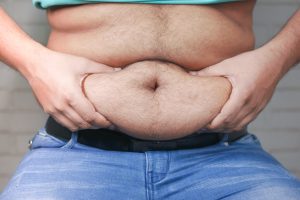Introduction
Excess belly fat, often referred to as the infamous “beer belly,” is a common concern for many men. It not only affects appearance but can also have significant health implications. This article delves into the world of male belly fat, examining its causes, effective solutions, and when surgical intervention becomes a necessary option. We will explore the characteristics of good candidates for non-surgical and surgical treatments, as well as the health risks associated with stubborn belly fat.
Why do men get big bellies?
- Poor Diet: Consuming a diet high in processed foods, sugary beverages, and excessive calories can lead to abdominal weight gain.
- Lack of Exercise: Sedentary lifestyles contribute to belly fat. A lack of physical activity leads to the accumulation of visceral fat, which surrounds internal organs.
- Stress: Chronic stress can trigger the release of cortisol, a hormone associated with abdominal fat storage.
- Genetics: Genetic factors can influence how and where your body stores fat.
- Aging: Metabolism slows down as we age, making it easier to gain weight, especially around the abdomen.
Why is belly fat dangerous?
Belly fat, particularly visceral fat, is not just a cosmetic concern; it’s also a health risk. Visceral fat surrounds vital organs and has been linked to a higher risk of various health issues, including:
- Cardiovascular disease
- Type 2 diabetes
- High blood pressure
- Sleep apnea
- Certain cancers
It’s essential to address belly fat not only for aesthetic reasons but also for overall health and well-being.

How to get rid of male belly fat?
For those with mild to moderate belly fat, non-surgical options may be effective:
- Diet and Exercise: A combination of a balanced diet and regular physical activity can help shed excess pounds and reduce belly fat.
- Lifestyle Changes: Managing stress, getting enough sleep, and reducing alcohol consumption can contribute to belly fat reduction.
- Medical Treatments: Some individuals may explore medical interventions, such as non-invasive body contouring procedures, to target stubborn belly fat.
What is the best surgery for male belly?
Surgical intervention is usually considered when non-surgical methods have been exhausted or for individuals with more significant abdominal concerns:
- Liposuction: Liposuction can surgically remove excess fat from the abdominal area, creating a flatter appearance. It is suitable for individuals with localized fat deposits.
- Tummy Tuck (Abdominoplasty): For those with excess skin and weakened abdominal muscles, a tummy tuck can provide a more comprehensive solution.

Who are good candidates for surgical vs. non-surgical male belly procedures?
Non-Surgical Candidates:
- Individuals with mild to moderate belly fat.
- Those committed to lifestyle changes, including diet and exercise.
- People willing to explore non-invasive medical treatments for body contouring.
Surgical Candidates:
- Individuals with significant belly fat and excess skin.
- Those seeking long-lasting results.
- People willing to undergo a surgical procedure and associated recovery period.

Conclusion
Male belly fat can be a persistent and detrimental issue, affecting both appearance and health. The approach to tackling this concern varies based on the severity of the condition. For those with mild to moderate belly fat, non-surgical options, including lifestyle changes, can be effective. However, when non-surgical methods fall short or for individuals with significant belly fat, surgical procedures such as liposuction or a tummy tuck may provide lasting solutions. Regardless of the chosen approach, the primary goal should be the improvement of health and overall well-being. Consultation with a qualified healthcare professional is crucial to determine the most suitable path to address your specific concerns and achieve a healthier and more sculpted abdominal region.
Disclaimer: The content on this blog is intended for general informational purposes only. It is not a substitute for professional medical advice, diagnosis, or treatment. Always consult qualified healthcare providers for personalized advice. Information regarding plastic surgery, dental treatment, hair transplant, and other medical procedures is educational and not a guarantee of results. We do not assume liability for actions taken based on blog content. Medical knowledge evolves; verify information and consult professionals. External links do not imply endorsement. By using this blog, you agree to these terms.





